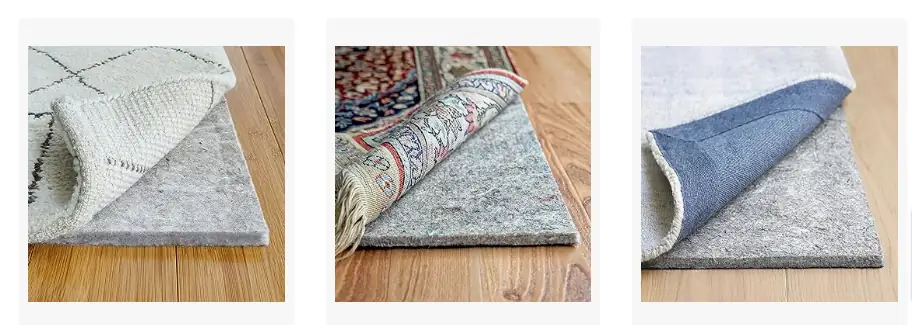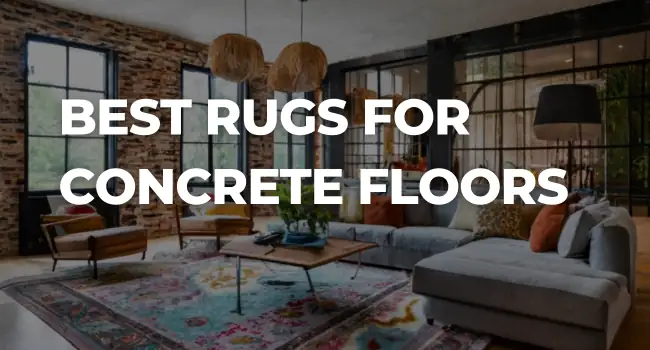Last updated on May 26th, 2024 at 06:27 am
Rugs for noise reduction are a practical solution for creating a quieter, more serene environment in your home or office. Can rugs reduce noise? Absolutely. They act as a sound absorber, reducing echo and minimizing the transmission of noise. Understanding the efficacy of rugs in noise reduction and discovering the best options is key to crafting a quieter space.
Do Rugs Really Help with Reducing Noise?
Rugs play a significant role in reducing noise within a room. Their dense, fibrous structure helps to absorb and dampen sound waves, making the space acoustically more comfortable. While they might not entirely eliminate noise, they substantially reduce its impact.
How Effective Are Rugs in Reducing Sound in a Room?
Rugs effectively dampen a variety of noises, particularly those caused by footsteps, furniture movement, or echo in an empty room. They are especially efficient in reducing high-frequency noises.
What Types of Noises Do Rugs Effectively Reduce?
Rugs excel at reducing impact noise, such as footfall, and airborne noise like conversation or television sound. They’re less effective in minimizing low-frequency noises like heavy machinery vibrations.
Are Certain Rug Materials Better for Noise Reduction than Others?
Materials like wool and high-density natural fibers, such as bamboo silk, are exceptional for noise reduction due to their ability to absorb sound waves effectively.
Types of Rugs for Noise Reduction
What Are the Best Materials for Noise-Reducing Rugs?
- Wool Rugs: Known for their natural noise reduction properties.
- Bamboo Silk Rugs: High-density fibers for effective sound absorption.
Are There Specific Rug Weaves or Styles Better for Reducing Noise?
- High Pile Rugs: Thicker piles absorb more sound.
- Shaggy or Frieze Rugs: Their depth helps in noise reduction.
Do Thicker Rugs Perform Better in Noise Reduction?
Thicker rugs, particularly those with higher pile depth, tend to perform better in reducing noise due to their increased ability to absorb sound waves.
Best Rugs for Noise Reduction – Reddit Advice
Reddit offers insightful advice from users who’ve experimented with noise-reducing rugs. Users recommend thick, high-density rugs for optimal noise reduction in rooms.
| Main Points |
|---|
| Preferences on rug colors; blue rugs mid-heavy, brown tamps highs, beige similar to brown but brighter. |
| Recommends 8×10 Persian rugs from Costco or Home Depot based on available floor space. |
| Seeks advice on leaving space for a tile floor; suggests rolling a large rug to experiment with acoustics. |
| Recommends thick Persian rugs and suggests using moving blankets underneath for added thickness. |
| Highlights the importance of considering the floor’s acoustic treatment, recommends fluffier rugs for absorbing acoustic information. |
| States that thick, heavy wool rugs are more absorbent than synthetic area rugs from big box retailers. |
| Recommends large, thick rugs for reducing reverberation but mentions limitations in addressing low-frequency reverb. |
| Suggests trying vinyl floors to test noise reduction before investing. |
| Engages in discussions regarding noise issues and potential solutions with neighbors. |
| Emphasizes that a single layer of carpet won’t fully stop impact noise; detachment/separation is crucial for noise reduction. |
| Reflects on personal experience with noise reduction through rugs, curtains, and wall decorations. |
| Describes vibrations caused by upstairs neighbors with recliners and hardwood flooring. |
| Relates to the struggles of noise from upstairs and shares similar experiences and sentiments. |
User Engagement and Topic Discussion
The comments provided various insights and personal experiences related to noise reduction, especially focusing on the use of rugs and other techniques. The conversations revolved around rug types, materials, and their effectiveness in reducing noise. Users discussed personal experiences with different types of flooring, neighbors’ noise, and potential solutions using rugs and other methods to minimize sound transfer. These insights can offer guidance to individuals facing similar noise issues in their living spaces.
Important Themes
- Rug materials and thickness for noise reduction.
- Consideration of floor type (tile, vinyl, hardwood) and its impact on noise reduction.
- Neighbor-related noise issues and potential resolutions.
- The limitations and effectiveness of rugs in reducing noise.
Please note that some comments were personal anecdotes and subjective experiences that might not be universally applicable.
Room-Specific Advice
Are There Specific Rugs Recommended for Bedrooms for Noise Reduction?
For bedrooms, opt for soft, high-pile rugs for comfort and noise reduction. Shaggy rugs or woolen carpets work exceptionally well.
- Thick and Plush Rugs: Look for rugs with a higher pile or thickness. Thicker rugs tend to absorb more sound compared to thinner ones.
- Material: Opt for rugs made from sound-absorbing materials like wool, shag, or certain synthetic materials designed to absorb sound. These materials can help muffle footsteps and other sounds.
- Size and Coverage: Choose a rug that covers a significant portion of the bedroom floor. This maximizes its impact on noise reduction.
- Rug Pads: Use a rug pad underneath the rug. Not only does it add extra cushioning and comfort, but it can also further enhance sound absorption.
- Layering Rugs: Layering rugs can increase sound absorption. Consider placing a smaller rug on top of a larger one for additional noise reduction.
- Acoustic Rugs: Some manufacturers offer rugs specifically designed for noise reduction, using materials and construction techniques aimed at absorbing sound.
- Wall-to-Wall Carpeting: If you’re open to larger changes, consider installing wall-to-wall carpeting in the bedroom. This offers significant noise reduction benefits.
What Rugs Work Best in High-Traffic Areas for Noise Reduction?
In high-traffic zones, durable and stain-resistant rugs like synthetic fiber or nylon rugs are recommended for noise reduction.
Do Rugs Work Better on Hardwood Floors or Carpets for Noise Reduction?
Rugs work well on both hardwood floors and carpets for noise reduction. However, they offer a more noticeable reduction on hard surfaces due to their capacity to absorb sound waves.
Installation and Placement
Is There a Specific Way to Place Rugs to Maximize Noise Reduction?
Placing rugs in the center of the room, covering the most exposed areas, and using rug pads can maximize noise reduction.
How Many Rugs Are Needed in a Room for Effective Sound Reduction?
The number of rugs required depends on the room’s size and layout. Generally, a combination of one large rug or multiple smaller ones can effectively reduce noise.
Should Rugs Be Placed Under Furniture for Better Noise Reduction?
Placing rugs under furniture helps in further reducing noise by covering more floor space and absorbing sound where it originates.
What Is the Best Soundproofing Under a Rug?
Adding a dense rug pad beneath the rug can significantly enhance its noise reduction capabilities by creating an additional layer of sound insulation.
- Rug Pad or Underlay: A dense rug pad or underlay made of materials like felt, rubber, or a combination of both can help reduce noise transmission. Opt for a thicker pad as it offers better sound absorption.
- Acoustic Underlayment: Acoustic underlayment is specifically designed to absorb and block sound. It often comprises materials like cork, rubber, foam, or combination layers engineered to reduce noise.
- Mass-Loaded Vinyl (MLV): Placing MLV underneath the rug can significantly reduce sound transmission. It’s a dense, flexible material that’s effective at blocking airborne noise and can be cut to size and placed discreetly beneath the rug.
- Cork Sheets: Thin cork sheets or rolls can also serve as an effective soundproofing layer. Cork’s natural properties help dampen sound and vibrations.
- Foam Insulation Mats: Closed-cell foam insulation mats, commonly used for insulating floors, can also act as an additional soundproofing layer beneath the rug.
Layering these materials can create a more effective soundproofing barrier, reducing both impact noise and airborne sound, ultimately enhancing the overall noise reduction qualities of the rug in your bedroom.
Comparison and Recommendations
What Are the Top-Rated Rugs for Noise Reduction?
Top-rated noise-reducing rugs include the Mohawk Home Ultra Premium Rug Pad and the RUGPADUSA Super Lock Natural Rubber Rug Pad.
Are There Specific Brands Known for Producing High-Quality Noise-Reducing Rugs?
Brands like Karastan, Mohawk, and Safavieh are recognized for their quality noise-reducing rug options.
Maintenance and Longevity
How Do I Maintain the Noise-Reducing Properties of a Rug?
Regular vacuuming and professional deep cleaning every 12 to 18 months help maintain a rug’s noise-reducing capabilities.
Do These Rugs Lose Their Noise Reduction Capabilities Over Time?
With proper care, noise-reducing rugs can maintain their efficiency for a significant period, often several years.
Are There Any Specific Cleaning Methods to Retain the Noise-Reducing Effect?
Professional cleaning using mild solutions preserves a rug’s noise-reducing properties while keeping it clean.
Comparing Rugs with Other Noise Reduction Methods
How Do Noise-Reducing Rugs Compare to Other Soundproofing Solutions?
While rugs are effective, combining them with soundproof curtains, acoustic panels, or wall coverings can further enhance noise reduction in a room.
Are Rugs Alone Sufficient for Noise Reduction, or Should They Be Combined with Other Methods?
Rugs, when used in combination with other soundproofing solutions, offer comprehensive noise reduction, especially in high-noise areas.
For more detailed information, you can refer to authoritative sources such as:
Expert Data Table: Noise-Reducing Rug Comparison
| Rug Type | Material | Effectiveness | Price Range |
|---|---|---|---|
| Wool Rugs | Wool | High | Moderate to High |
| Bamboo Silk Rugs | Bamboo Silk | High | Moderate to High |
| High Pile Rugs | Various | High | Moderate to High |
| Synthetic Fiber Rugs | Synthetic Fiber | Moderate | Low to Moderate |
| Rug Pads | Rubber, Felt | Variable | Low to High |
In conclusion, noise-reducing rugs are a valuable addition to any space seeking a quieter ambiance. By understanding the types, materials, and placements that optimize their effectiveness, you can create a more tranquil environment. Incorporating these rugs, along with proper maintenance, will ensure sustained noise reduction and a peaceful atmosphere in your home or workplace.
Remember, a quieter space is just a rug away!



